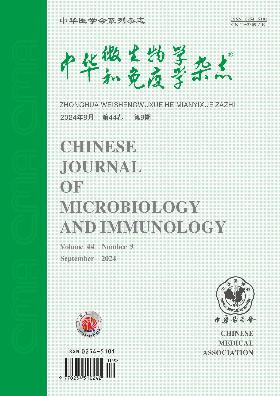杭州地区吐吐型蜡样芽孢杆菌基因组特征及毒力因子分析
Q4 Immunology and Microbiology
引用次数: 0
摘要
目的研究杭州地区食物中呕吐型蜡样芽孢杆菌菌株的基因组特征和毒力因子,以更好地了解其致病潜力。方法采用实时PCR方法对2015~2017年从食品中分离的132株蜡样芽孢杆菌进行ces基因簇(cereulide)检测。使用Illumina MiSeq测序平台对蜡样蛋白阳性菌株的基因组进行测序。在组装基因组序列后进行基因组注释、毒力因子检测、比较和进化分析。结果12株(9.09%)携带ces基因。它们的基因组大小在5.35至5.75Mb之间,GC含量在35.25至35.43mol%之间。它们均携带完整的蜡样蛋白生物合成基因簇、非溶血性肠毒素(NHE)编码基因簇(nheA、nheB和nheC)和溶血素Ⅲ(hlyⅢ)。12株菌株与参考菌株NC7401(登录号:AP007209)的平均核苷酸同一性(ANI)超过99.35%。系统发育分析表明,这些菌株与NC7401和AH187的本地临床分离株和呕吐型蜡样芽孢杆菌菌株聚为同一分支。结论杭州地区从食品中分离到的呕吐型蜡样芽孢杆菌菌株与参考菌株NC7401的基因组序列高度相似。基因组分析结果表明,这些分离株携带许多与致病性有关的毒力因子。关键词:蜡样芽孢杆菌;基因组测序;毒力因子;基因组分析本文章由计算机程序翻译,如有差异,请以英文原文为准。
Analysis of genomic characteristics and virulence factors of emetic-type Bacillus cereus strains isolated in Hangzhou
Objective
To investigate the genomic characteristics and virulence factors of emetic-type Bacillus cereus strains isolated from food in Hangzhou for better understanding their pathogenic potential.
Methods
Real-time PCR was performed to detect the ces gene cluster (cereulide) in 132 Bacillus cereus strains isolated from food from 2015 to 2017. Genomes of cereulide-positive strains were sequenced using Illumina MiSeq sequencing platform. Genome annotation, virulence factor detection, comparative and evolutionary analysis were performed after the sequences of genomes were assembled.
Results
Twelve strains (9.09%) carried the ces gene. Their genome sizes ranged from 5.35 to 5.75 Mb and GC contents from 35.25 to 35.43 mol%. All of them harbored the full cereulide biosynthesis gene cluster, nonhemolytic enterotoxin (NHE)-encoding gene cluster (nheA, nheB and nheC) and hemolysin Ⅲ (hlyⅢ). The average nucleotide identity (ANI) between the 12 isolates and the reference strain NC7401 (Accession number: AP007209) was over 99.35%. Phylogenetic analysis demonstrated these strains were clustered into the same branch with local clinical isolates and the emetic-type Bacillus cereus strains of NC7401 and AH187.
Conclusions
The genomic sequences of the emetic-type Bacillus cereus strains isolated from food in Hangzhou area were highly similar to that of the reference strain NC7401. Results of the genomic analysis suggested that these isolates carried many virulence factors that were related to pathogenicity.
Key words:
Bacillus cereus; Genome sequencing; Virulence factor; Genomic analysis
求助全文
通过发布文献求助,成功后即可免费获取论文全文。
去求助
来源期刊

中华微生物学和免疫学杂志
Immunology and Microbiology-Virology
CiteScore
0.50
自引率
0.00%
发文量
6906
期刊介绍:
Chinese Journal of Microbiology and Immunology established in 1981. It is one of the series of journal sponsored by Chinese Medical Association. The aim of this journal is to spread and exchange the scientific achievements and practical experience in order to promote the development of medical microbiology and immunology. Its main contents comprise academic thesis, brief reports, reviews, summaries, news of meetings, book reviews and trends of home and abroad in this field. The distinguishing feature of the journal is to give the priority to the reports on the research of basic theory, and take account of the reports on clinical and practical skills.
 求助内容:
求助内容: 应助结果提醒方式:
应助结果提醒方式:


